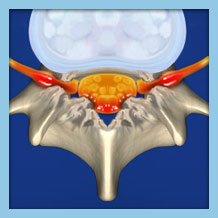

Back pain is a common issue many people experience at some point in their lives. For some, it’s a temporary nuisance, but for others, it can become chronic and debilitating. When conservative treatments like physical therapy or medications fail to provide relief, spinal decompression surgery may be an option. This procedure is designed to relieve pressure on the spinal cord or nerves, which can alleviate pain, numbness, and other symptoms associated with conditions like herniated discs, spinal stenosis, or degenerative disc disease.
At Orthopedic & Laser Spine Surgery (OLSS), we understand how severe back pain can impact your life. We’re here to help patients find the most effective solutions, including spinal decompression surgery, which can provide long-term relief when less invasive treatments no longer work.
What is Spinal Decompression Surgery?
Spinal decompression surgery is a procedure designed to relieve pressure on the spinal cord and surrounding nerves. This pressure often results from conditions such as herniated discs, spinal stenosis, or spondylolisthesis. During the surgery, the surgeon removes portions of the bone, disc material, or ligaments pressing on the nerves or spinal cord. This alleviates the painful symptoms caused by compression and may restore some of the nerve function that was compromised.
There are different types of spinal decompression surgeries depending on the cause and location of the compression. A common procedure is a laminectomy, where part of the vertebral bone (lamina) is removed to create more space for the spinal cord and nerves. Another option is a discectomy, where a portion of a herniated or bulging disc is removed to alleviate nerve pressure. In more complex cases, spinal fusion may be performed alongside decompression to stabilize the spine.
The goal of spinal decompression is to provide lasting relief. Patients typically experience significant improvements in their symptoms, including a reduction in pain, increased mobility, and improved quality of life. However, it is important to note that surgery is generally considered only after conservative methods have been exhausted.
Who Might Need Spinal Decompression Surgery?
Spinal decompression surgery is not for everyone experiencing back pain. It is generally recommended for patients whose symptoms have not improved after months of non-surgical treatments, including physical therapy, medications, or epidural steroid injections.
Candidates for the surgery are often those with specific conditions that cause spinal cord or nerve compression, such as:
- Herniated discs: A herniated disc can press against the nerves in your spine, causing pain, numbness, or weakness in your arms or legs. Decompression surgery can relieve this pressure and help you regain function.
- Spinal stenosis: This condition involves the narrowing of the spinal canal, which can compress nerves and cause discomfort. Decompression surgery creates more space within the spinal canal, relieving pressure on the affected nerves.
- Spondylolisthesis: When one vertebra slips over another, it can lead to nerve compression and instability in the spine. Surgery can alleviate the pressure and may involve spinal fusion to stabilize the spine.
These conditions can lead to chronic pain, weakness, or difficulty walking. For patients with severe symptoms, spinal decompression surgery may be the best solution to restore their ability to perform daily activities.
Recovery and Risks of Spinal Decompression Surgery
Like any surgery, spinal decompression carries risks, but advancements in minimally invasive techniques have made this procedure safer and recovery times quicker. The specific recovery process depends on the type of surgery performed and the patient’s overall health. Minimally invasive techniques, like those often performed at OLSS, involve smaller incisions, which result in less blood loss, reduced risk of infection, and a quicker return to normal activities.
After surgery, most patients can expect to stay in the hospital for a short period, usually just one or two days. Physical therapy often follows, focusing on strengthening the muscles around the spine and improving flexibility. Most patients will begin to see improvements in their symptoms within a few weeks, with full recovery taking anywhere from several weeks to a few months.
However, as with any surgical procedure, there are potential risks. These include infection, blood clots, nerve damage, or complications related to anesthesia. It is essential to have a thorough discussion with your surgeon about these risks before deciding on surgery. In most cases, the benefits far outweigh the risks, particularly for patients who have been dealing with debilitating pain.
Is Spinal Decompression Surgery Right for You?
Deciding whether spinal decompression surgery is right for you depends on several factors. It’s important to consider the severity of your symptoms, the results of any imaging tests like MRIs or CT scans, and your overall health. Patients experiencing nerve-related symptoms like numbness, tingling, or weakness in their extremities, or those whose mobility is severely restricted, may be good candidates for surgery.
It’s also crucial to consider whether other treatments have been exhausted. Most doctors recommend trying non-surgical options first, as surgery is typically considered a last resort. If months of conservative treatments have failed to provide relief, and your symptoms significantly impact your quality of life, surgery may offer a more permanent solution.
Keep in mind that every patient is different. While spinal decompression surgery has helped countless individuals return to their normal activities, it’s not a guaranteed solution for everyone. A thorough evaluation by a spine specialist is the first step in determining if this procedure is right for you.
Why Choose OLSS for Your Spinal Decompression Surgery?
At Orthopedic & Laser Spine Surgery, we are dedicated to providing the highest level of care for our patients, particularly when it comes to minimally invasive procedures like spinal decompression surgery. Our team of surgeons has decades of experience performing these surgeries, and our state-of-the-art facilities are equipped with the latest technology to ensure the best outcomes for our patients.
We understand surgery is a significant decision, which is why we take the time to walk you through every step of the process—from your initial consultation to your post-operative care. Our minimally invasive approach means that you can expect a quicker recovery and less postoperative pain compared to traditional surgical methods. If you’re considering spinal decompression surgery, call us today at (866) 272-9271 or fill out our contact form to schedule your consultation.
FAQs About Spinal Decompression Surgery
What are the types of spinal decompression surgery?
Spinal decompression surgeries include:
- Laminectomy
- Laminotomy
- Laminoplasty
- Discectomy
- Microdiscectomy
These procedures address conditions like herniated discs or spinal stenosis, especially in the lumbar (lower back) region.
How serious is spinal decompression surgery?
While spinal decompression surgery is generally safe, there are rare risks, including complications like blood clots, adverse reactions to anesthesia, and blood loss. Though the risk of death is minimal, it’s still a potential concern.
How long does it take to recover from spinal decompression surgery?
Recovery from spinal decompression surgery takes at least six weeks, though full recovery may take longer depending on the severity of your condition before surgery. Mobility and function gradually improve during this period.
What is the success rate of spinal decompression surgery?
The success rate of spinal decompression surgery, particularly laminectomy, is around 90%, with over 75% of patients reporting satisfaction. However, individual results can vary based on the specific condition and procedure.
When can I have sex after spinal decompression surgery?
It’s generally safe to resume sexual activity a few weeks after spinal decompression surgery, but this will depend on the specific procedure and your recovery progress. Always consult your surgeon for personalized advice, as some patients may need to wait longer.
When can I start driving after spinal decompression surgery?
Most patients can start driving again within two to six weeks after spinal decompression surgery, depending on the extent of the surgery and how well you’re recovering. It’s important to wait until you’re no longer taking pain medication and feel comfortable turning your head and sitting for extended periods.
Will spinal decompression surgery leave a scar?
Yes, spinal decompression surgery typically leaves a small scar, especially if a minimally invasive technique is used. These incisions are usually much smaller than traditional surgery, resulting in less noticeable scarring. Over time, the scar will fade, but it will remain visible to some extent.
